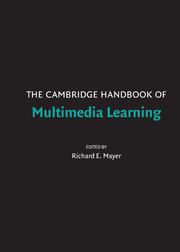Book contents
- Frontmatter
- Contents
- Preface
- Contributors
- 1 Introduction to Multimedia Learning
- PART I THEORETICAL FOUNDATIONS
- PART II BASIC PRINCIPLES OF MULTIMEDIA LEARNING
- PART III ADVANCED PRINCIPLES OF MULTIMEDIA LEARNING
- PART IV MULTIMEDIA LEARNING IN CONTENT AREAS
- PART V MULTIMEDIA LEARNING IN ADVANCED COMPUTER-BASED CONTEXTS
- 31 Multimedia Learning with Animated Pedagogical Agents
- 32 Multimedia Learning in Virtual Reality
- 33 Multimedia Learning in Games, Simulations, and Microworlds
- 34 Multimedia Learning with Hypermedia
- 35 Multimedia Learning in e-Courses
- Author Index
- Subject Index
- References
33 - Multimedia Learning in Games, Simulations, and Microworlds
Published online by Cambridge University Press: 05 June 2012
- Frontmatter
- Contents
- Preface
- Contributors
- 1 Introduction to Multimedia Learning
- PART I THEORETICAL FOUNDATIONS
- PART II BASIC PRINCIPLES OF MULTIMEDIA LEARNING
- PART III ADVANCED PRINCIPLES OF MULTIMEDIA LEARNING
- PART IV MULTIMEDIA LEARNING IN CONTENT AREAS
- PART V MULTIMEDIA LEARNING IN ADVANCED COMPUTER-BASED CONTEXTS
- 31 Multimedia Learning with Animated Pedagogical Agents
- 32 Multimedia Learning in Virtual Reality
- 33 Multimedia Learning in Games, Simulations, and Microworlds
- 34 Multimedia Learning with Hypermedia
- 35 Multimedia Learning in e-Courses
- Author Index
- Subject Index
- References
Summary
Abstract
This chapter reviews and critiques the scientific evidence and research methods studying the use of games, simulations, and microworlds as multimedia learning tools. This chapter focuses on interactive educational multimedia, which is distinguished from scripted forms of educational multimedia by the degree to which users participate in and control the multimedia software. This chapter also uses the distinction between explanation and experience to understand the unique design opportunities of interactive educational multimedia. The strongest empirical evidence comes from the simulation literature, especially that related to questions about how to design a simulation's interface to provide feedback and questions about students engaged in discovery learning activities. Microworld research is less empirically rigorous with evidence continuing to remain largely anecdotal based on implementation reports. Research on gaming is the most transitory, ranging from early research on learning from playing games to learning from designing games. Current debates among educational researchers about what constitutes scientific research are particularly relevant to anyone interested in research about interactive multimedia due to the increased use of qualitative research methodologies and the newly emerging trend toward design experiments.
What Is Multimedia Learning in Games, Simulations, and Microworlds?
The purpose of this chapter is to review the scientific evidence on the use of games, simulations, and microworlds as multimedia learning tools. This is a tall order. All three have very distinctive design and research pedigrees resulting in many cases from very distinctive philosophies about education.
- Type
- Chapter
- Information
- The Cambridge Handbook of Multimedia Learning , pp. 549 - 568Publisher: Cambridge University PressPrint publication year: 2005
References
- 90
- Cited by

